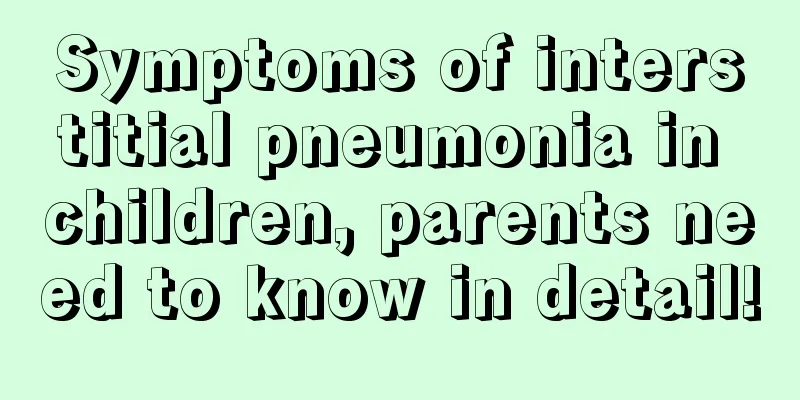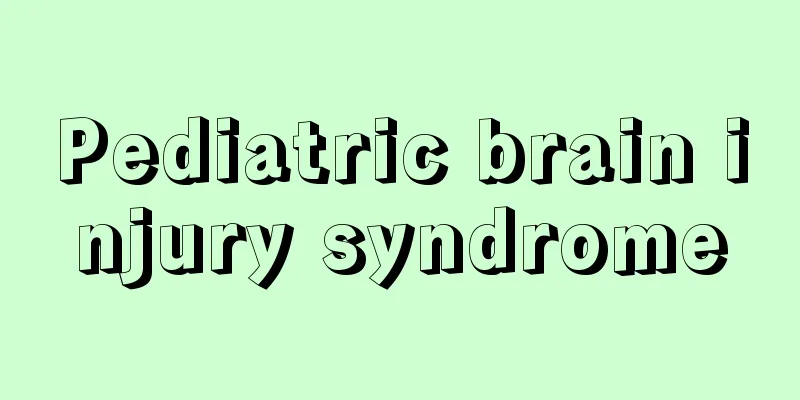Symptoms of interstitial pneumonia in children, parents need to know in detail!

|
Children are a group that is susceptible to pneumonia. If a child suffers from interstitial pneumonia, there will be some obvious symptoms, such as difficulty breathing, coughing, and dislike of eating, etc. In addition, there are many other symptoms. 1. Symptoms of interstitial pneumonia in children Interstitial pneumonia is often difficult to detect during its onset, and it often takes months to years from the onset of symptoms to a clear diagnosis. The main clinical manifestations are dyspnea, tachypnea and cough. Rapid breathing is common, especially in infants, and may manifest as retractions and feeding difficulties. Older children mainly show symptoms of exercise intolerance. Cough is mostly dry cough, which is also a common symptom and sometimes the only manifestation of interstitial lung disease in children. Other symptoms include coughing up blood, wheezing, and, in older children, chest pain. There are also systemic manifestations such as growth retardation, lack of appetite, fatigue, and weight loss. The infected person may have fever, cough and sputum. Acute interstitial pneumonia has a rapid onset and respiratory failure occurs quickly. When you take a deep breath, you can hear fine, crisp crackles at the lung base and shoulder blade area, also known as Velcho's rales. Clubbing of the fingers and toes soon develops. Cases with pulmonary hypertension may have symptoms of right heart hypertrophy such as hypertrophic and splitting second heart sound. 2. Health care measures for children with interstitial pneumonia 1) Maintain good nutrition and proper weight: Good nutrition is very helpful in maintaining an ideal weight. Patients with chronic lung disease eat less for fear of shortness of breath when eating, which leads to malnutrition. Low nutrition weakens the respiratory muscles, thereby aggravating shortness of breath. In addition, being overweight increases the burden on the heart and lungs to supply oxygen to the whole body, which also leads to shortness of breath. Being overweight also increases the pressure on the diaphragm and causes insufficient breathing. 2) Face the disease with a scientific attitude and a positive and peaceful mind. Do you choose to be sad, happy, or mad? Should we choose to be positive or negative? Although the choice may not solve all problems, it will definitely make a difference in how you deal with your pulmonary fibrosis and the results it brings. Therefore, it is wise to actively participate in the entire process of disease treatment. 3) Exercise regularly and maintain body shape: Lung disease and shortness of breath reduce patients' mobility and make them easily fatigued. Lack of oxygen causes fear and psychological pressure in patients. Therefore, patients with chronic lung disease sometimes limit their activities to avoid shortness of breath. In particular, family members also advise patients to move less, otherwise it will be harmful (to the body). However, lack of exercise can cause muscles to not be as strong and efficient as before, and it may even develop to the point where even light daily activities become difficult; on the contrary, through regular exercise such as simple walking, muscles will become stronger and more resistant to fatigue. In short, through regular training, you can learn to use more effective methods to complete your work. As a result, you will need less oxygen to complete the same amount of work and your shortness of breath will be reduced. 4) Learn and practice relaxation: Anxiety and pessimism are common in patients with chronic lung disease and can worsen the condition; shortness of breath, decreased mobility, and pessimism may cause patients to isolate themselves from family and friends. Learning to relax can help control the fear that comes with shortness of breath; physical and mental relaxation can prevent excessive oxygen consumption due to muscle tension. 5) Avoid infection: Infection will aggravate your symptoms and condition, but because you are used to breathing poorly, you tend to ignore small changes in breathing and aggravated coughing, or think they are unimportant. You should report new symptoms or changes in symptoms to your doctor promptly so that treatment can be initiated as soon as possible. Getting a flu shot every year can reduce the incidence of complications and hospitalizations caused by the flu. In addition, pneumonia vaccines are also available to prevent pneumonia caused by specific bacteria. Ask your doctor if these vaccines are right for you. 3. Prevention of interstitial pneumonia in children 1. Keep warm and prevent colds. Because the upper respiratory tract loses its barrier function after a cold, the bacteria will go straight into the lungs and cause interstitial pneumonia. If you experience symptoms of upper respiratory tract infection such as sore throat, nasal congestion, and cough, you should seek timely treatment to prevent bacteria from invading the lungs and developing into interstitial pneumonia. 2. The body's resistance is closely related to nutrition, so nutrition should be strengthened. In the diet, you should choose high-protein, high-carbohydrate, low-fat foods and vegetables and fruits rich in vitamin A and vitamin C. For example, eat more fresh fish, lean meat, beef, mutton, chicken and eggs, cauliflower, carrots, tomatoes, apples, bananas, pears, etc. to improve the body's resistance and prevent interstitial pneumonia. 3. Keep the room clean and ventilated, maintain good indoor hygiene, and keep the air fresh. |
<<: Parents need to see the symptoms of lobar pneumonia in children
>>: The baby has repeated coughing and fever, these treatments are very effective
Recommend
Children's growth and development indicators
Ten months of pregnancy and one day of delivery e...
Why does my baby have a blocked nose due to a cold?
A while ago, a friend often said that her two-yea...
Why does my baby have diarrhea after drinking milk?
What worries families the most when babies are dr...
When is the best age for children to have orthodontic treatment?
Many parents find that their children’s teeth are...
What causes neonatal enteritis?
Every parent hopes that their children can grow u...
What should I do if my child has a big bump on his forehead?
Bumps and bruises are inevitable in life. Every c...
Is it okay for a three-month-old baby to take a bath frequently?
Should a 3-month-old baby take a bath frequently?...
What should I do if my baby has cavities?
It is very common for children to have tooth deca...
What should we do if children have amblyopia?
Amblyopia in children is a relatively common eye ...
Symptoms of otitis media in children
Otitis media is one of the most common ear diseas...
How is Mycoplasma pneumoniae infection treated?
Mycoplasma pneumoniae infection is a disease caus...
Why does a child vomit when coughing? This is the reason!
Some children are prone to vomiting when they cou...
What should I do if my one and a half year old child is constipated?
Children are very prone to constipation, especial...
What should I do if my newborn baby hasn’t defecated for two days?
Babies are more prone to constipation, but it has...
What to do if your child has red and swollen gums
Children's teeth are in a developmental stage...









